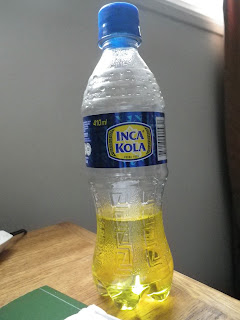This week at Bridge of Hope was unusually hectic because Maribel, Jed, and a couple of artisans are visiting the U.S. for a couple of weeks. Imke and Jenny met their match with the bureaucracy of Peruvian customs and shipping while I looked helplessly on. I can't exactly sum up what my job with BOH is yet because I don't precisely know, but I'm sure that once I figure it out it will be awesome.
Wednesday was Dia del Pescador, or fisherman's day, which is a work-free holiday for many Peruvians. Imke and I spent our Dia del Pescador visiting Museo Larco which, besides being one block away from my house, has one of the largest collections of pre-Columbian art as well as an erotic pottery exhibit. Come find me if you want to see pictures of that when I get back because I definitely won't be posting them on my blog. The museum itself is an old mansion built on top of 7th century ruins and boasts a magnificent garden that spills over the walls to the street. As we navigated the exhibits we saw tons of pre-Jesus pottery and textiles that were so well preserved they may as well have been bought yesterday in Lima at the Mercado del Indio.


One of the most interesting items was a quipu, which is a series of strings that are knotted and colored in particular ways to store information about economic output, census, business transactions, etc. In fact, Imke and I saw the very same quipu that's featured on the quipu wikipedia page! Check it! The other impressive part of the exhibit was the staggering amount of gold ornaments worn by Incan nobility: earrings, nose rings, necklaces, head pieces, and breastplates.
 |
| These are old timey ear plugs. Hipsters, eat your hearts out. |
Once we stopped gawking at the impressive collection of "erotic ceramics" we left the exhibit, snuck through the museum's tourist-priced restaurant, and headed down Bolivar to grab a great lunch at a cheap little restaurant in Jesús María. Here's something I love about Lima: Imke helped me buy a cheap phone from a Metro (supermarket) and I remembered I needed some nail clippers so we headed back to the pharmacy section. The only ones they had in the store were 28 soles! That's like ten dollars! So I gave up my search and resigned myself to remaining nailclipperless, but not even a block away from the Metro I spotted a tiny little man selling random trinkets on the side of the street and lo and behold, he had an array of novelty nailclippers for one sol! No matter where you are in Lima, someone on the street is always selling what you need, whether that be picarones, sewing needles, bibles, or nailclippers.
Yesterday Imke and I broke down and went to Miraflores to grab some good ol' American pizza. We felt like exploring so we stopped by a little shop and bought "chocotejas," which are awesome little chocolates filled with some kind of dulce de leche. Then we headed down the main street to Larco Mar, a shopping mall built into the cliffs that overlook the sea. It wasn't so much a mall as a glorified food court and refuge for tourists because it was the most opulent, clean,
nice place I had seen in Peru thus far. It had a North Face store, PacSun, toy stores, shoe stores, souvenir shops, and even a Dunkin' Donuts.
 |
| The view from Larco Mar |
 |
| I live in the blue house on the right! |
Lima is sometimes shocking because unbelievable wealth often sits right next to undeniable poverty. This week I went with Jenny in a taxi to drop off some materials at a bus station in the center of Lima. On my last trip to the center of Lima I saw the presidential palace; on this trip, however, I saw people trying to sell shoes and lamps they found in the garbage or drunkenly trying to cross the street or begging at each car that passed. My mom told me that Peru will experience a 6% growth in its GDP this year, but from what I have seen and heard from folks at the office, that economic growth will go unnoticed by almost all Peruvians except the hombres at the top. In a few weeks, though, I'll go to places like La Oroya and Huancavelica and see firsthand the poverty that resulted from the corruption and terrorism in Peru's recent history, which is what groups like Bridge of Hope are trying to change.
Happy 4th of July weekend, everyone! Enjoy some burgers n hotdogs for me!




























